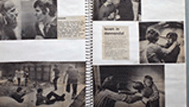10 February till 18 March 2014
DE WISSEL
Domenico Mangano

Beetsterzwaag, 3 February 2014 – From 10 February, Domenico Mangano will spend six weeks in Kunsthuis SYB. With a group of clients from De Wissel, he will make a children’s book and a video about De Wissel. Mangano will go out with clients almost daily and the clients will actively participate in the process of making the book and the video.
This project stems from Mangano’s fascination with groups at the margins of society.
Hidden in the green area of Beetsterzwaag is what looks like a typical residential neighbourhood: De Wissel. But this area is far from ordinary. The people in De Wissel live with Talant and find it hard to live in normal society. They have a mental disability and their behaviour can be hard to read at times. Some of the people who live and work at De Wissel have multiple disabilities. They live together in this village that is designed in such a way that they can live their own lives without losing contact with the rest of society; the whole terrain of De Wissel, including a bicycle repair shop, a petting zoo and gardens, are accessible to all the residents of Beetsterzwaag.
In 2014, this institution functions as a quiet, structured and safe haven. The Italian artist Domenico Mangano is fascinated by such small communities in the margins of society and delved into the history of the philosophy behind De Wissel. He came across a special episode in the Dutch care of the mentally handicapped: Nieuw Dennendal. From the assertion that the patient is, first and foremost, a person like any other, the psychologist and director of Dennendal, Carl Muller, opened his institution to the outside world at the end of the sixties. The self-development of the patients was the central premise of the new policy. Muller invited ‘normal’ people to mix with the psychiatric patients. A commune arose in which, according to critics, the battle against the outside world quickly became more important than the care for the patients. What started as an idyll, ended in an evacuation, ordered by the Dutch state. Mangano linked Carl Muller’s experiment with the last novel by the Italian author, Luigi Pirandello, One, No one and One Hundred Thousand (1926). The book is the culmination of Pirandello’s arduous quest for authenticity. At the end of the novel, the protagonist is voluntarily admitted to a psychiatric institution so he longer has to answer to the identity that his environment imposes on him.
In earlier times, people with intellectual disabilities were described as crazy and the madman in the arts often serves as an inspiration for society, Mangano stresses. With Muller’s philosophy in mind and Pirandello’s novel in hand, Domenico Mangano will walk among the inhabitants of the Wissel for six weeks, in search of something that can inspire us. Together with a few clients, he will make a book with drawings and collages in which their way of experiencing the world is central. The book will then be the basis of a video in which clients of Talant will act out the scenes themselves. In this process, the role of the artist is explicitly that of an observer and guide.
Domenico Mangano (1976) attended the Academy of Art in Palermo and has since then lived and worked in several places around the world (including Athens, Shanghai and New York). At this moment, he is staying in Amsterdam. Mangano is fascinated by de marginality of human existence in the contemporary, urban environment. The central themes in his videos, photographs and performances are immigration, identity and the relation between the private and the community.
Residency:
February 10 to march 18
Opening times:
Saturday & Sunday 13:00-17:00
and by appointment
Celebratory presentation:
Saturday March 15 at 14:00
REVIEW:
ABOUT SINGING ON THE BIKE AND PUBLIC INSANITY
by: Brenda Tempelaar
translation: Jenny Wilson
Many people in Amsterdam sing on their bikes. In Beetsterzwaag too, the difference being that the song of a cyclist in Beetsterzwaag is brought about by a blissful feeling of simplicity, significance and regularity. A rare form of happiness that can be found in traversing one and the same pattern day in day out. In Amsterdam on the other hand, people sing out of insanity, wedged in by the walls of Dutch society in which current affairs go according to plan. In Amsterdam, cyclists have right of way over road-crossing pedestrians. If this escapes your attention for a moment you’ll quickly be reminded of it by the loud moans and groans of the crossing pedestrian who has not taken well to your deviant behaviour. If you’re still inclined to sing after this kind of Amsterdam confrontation then it’s just to rid yourself of the regulations we impose on each other.
In Amsterdam insanity can be found on the street. In a man speaking to himself, the nervous twitches of a young man uncontrollably revealing himself to society, and yet no one really takes any notice. It has its own place within the system of social stipulations and passes over us just as easily as well-meaning solidarity at a zebra crossing. Visual artist Domenico Mangano (1976) swapped this (and other) social misconceptions for a residency in Kunsthuis SYB. In a place of norms and values, Beetsterzwaag, insanity is no less present, at most just less visible. And is it not precisely there, in the transition area between the invisible and the visible, that the artist can play a significant role? At the same time it raises questions about the aestheticisation of insanity and the manner in which one generally distributes value judgments as one pleases.
In Mangano I encountered a rare form of sensibility with regards to the traversing of fragile border areas between moralisation, aestheticisation and romanticisation. He devoted his stay in Kunsthuis SYB to achieving an insider position in De Wissel, a health care institution that strives to allow people with a mental health disability to lead independent lives. Mangano became part of daily life in De Wissel, a micro-society with its own activities, rhythms and amusements. During this process Mangano wasn’t looking for what he as an artist could say but what this society could tell him. Without a predetermined plan, without set expectations, he began to capture the residents on camera. It quickly became clear that he wasn’t waiting for the perfect, documentary portrait – the sensitive picture – but for the insignificant moments. Moments in which the ‘ordinary’ presents itself. At the end of his residency, Mangano showed a short, provisional montage of these images together with a selection of photographs, drawings he was given by residents of De Wissel, books that have inspired him and a subtle intervention of small twigs that he pricked through the holes on the wall made by preceding artists to hang their work. During our meeting, a smiling Mangano told me about how, in the presentation of his work, this installation was destroyed by children and residents of De Wissel as they came to admire his work, although without any conventional sense of art, let alone how to deal with it.
The informal character of his presentation, together with the way in which Mangano was able to get people in front of his camera means that I, as a viewer, can mirror myself in his interpretation of the ordinary and can conceive my own herein. He permits irony in his presentation, without ridiculing his encounters. As I’m sat looking at the video I catch myself having to stifle a laugh upon seeing a woman imitating Jennifer Lopez from a video clip on the telly. Behind her a woman looks on whilst being rocked back and forth by a moving bed. After a while the dancing woman notices the camera but the realisation that she’s being watched doesn’t change a thing about her performance. The unposed character of this scene is disarming and yet I still have difficulty in letting the outside world know how funny I find it. A little later Mangano himself is laughing because of Henk, who is showcasing his new sunglasses and doing a report on this in unintelligible Dutch.
In the back of the presentation space, on the garden side, Mangano shows drawings by the residents that depict a childish imagination: many of the drawings take the form of a pizza, which can be ascribed to Mangano’s Sicilian origins. Although these drawings somewhat swerve from Mangano’s true interests, they show a sensitive insight into the workings of our intellect, upon which one can project endless theories of philosopher’s such as Freud or Foucault. This also turns out to be correct as the ‘The History of Madness’ by Michel Foucault can be seen on the table on which Mangano presents his research. But I suspect that Mangano will never secure these links in an artwork. On the contrary, he is specifically interested in opening up diverse ways of thinking and increasing social acceptance.
This undoubtedly will not be the last we hear of Mangano’s project. Although he displays various initiatives and the video montages are promising, it seems that none of the methods employed are suited to capture what has happened to him as a familiar face in De Wissel in the past weeks. What his presentation shows is a quest for a translation of real encounters in a fitting representation. Achieving a position as an insider after all demands a human presentation of the work, instead of a representation in an Amsterdam gallery.
